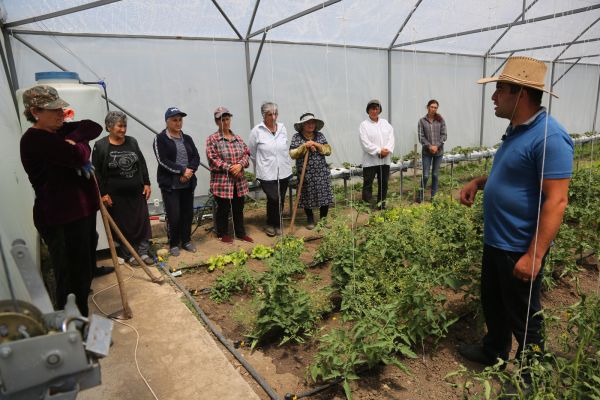The Teach-In Greenhouse in Hartagyugh Community has Revolutionised the Residents’ Understanding of Agriculture

In 2022, with the support of the “EU-Green Agriculture” Initiative, the “Little Star” charitable foundation built a teach-in greenhouse and an anti-hail network for an open ground test field in the Hartagyugh community of Lori region. This greenhouse has led to initial changes in the community, supporting about 187 farms in learning about greenhouse products and creating them based on their own experience.
Mariam Antonyan, Director of the “Little Star” charitable foundation, says that the choice of the region was accidental. It was important for the foundation to support households that have fertile land, which, for various reasons, has not been cultivated for years. “The Hartagyugh community was ideal from that point of view,” says Antonyan. According to her, the teach-in greenhouse has revolutionised the ideas of the residents of Hartagyugh community about agriculture because, previously, it was not possible to grow certain types of plants in that region due to its climatic features.
“Within the framework of our program, the residents-beneficiaries of the community are involved in the works for almost a year,” says Mariam Antonyan. First, the residents participate in courses, and then they move from theory to practical activities. With special tools, they plant small seeds in the soil, monitor the whole process to ensure the crop is not damaged, and only then receive the harvest.
In the teach-in greenhouse, which occupies an area of more than 200 square meters, the result of the product created by the residents of the community is divided into two equal parts.
“This way, we tried to introduce a social entrepreneurship model. The residents take 50 percent of the greenhouse products created by the community for their personal use, and the remaining 50 percent is sold by the foundation for various purposes,” explains Mariam Antonyan.
Using this model as well as various grants, the “Little Star” charitable foundation pays specialists with expertise in different fields of agriculture. Moreover, thanks to the implemented model, 30 households of the community had the opportunity to get a hothouse to implement green agriculture on their own land.
According to Antonyan, such an approach sparked interest among the residents of the community and the region, and more and more people apply to participate in the program.
It is noteworthy that only women were involved in the program from the Hartagyugh community with about 300 households and more than 1100 residents. According to Antonyan, such statistics may be related to the fact that most men are engaged in external work, while women, staying in the community, carry out their work not far from home.
“However, trends have started to change, and more young men have applied to our ongoing program. They are currently in the learning phase. Furthermore, at this stage of the project, we decided to expand and involve the residents of the Spitak community as well because we saw the efficiency of the program at the previous stage,” says Mariam Antonyan.
The transition to green agriculture in Hartagyugh is attracting new beneficiaries to the programme, because at the end of the agricultural project, students receive greenhouses to grow their own economy. Thanks to their hard work, the villagers of the plains are able to overcome the cold climate, proving that it is no longer an obstacle for growing tomatoes and eggplants, watermelons, and melons. According to Antonyan, the courses have taught the villagers of the plains about early planting in the spring, which makes it possible to have an earlier harvest in the open field and to grow crops that were previously imported into the community from other regions of Armenia and abroad.